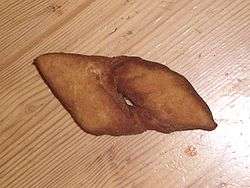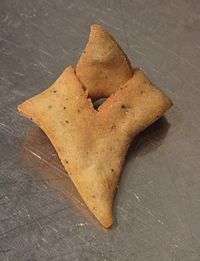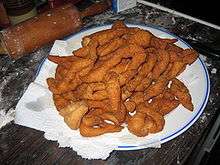Klenät
 | |
| Alternative names | Klena, Klejne, Kleina, Kleyna, Fattigmann |
|---|---|
| Type | Doughnut |
| Region or state | Northern Europe |
| Main ingredients | flour, egg yolks, sugar, margarine or butter |
|
| |
Klenät, klena, klejne, kleina, kleyna, and fattigmann are all names for a fried pastry common in the Nordic countries. It is also found in nearby countries (such as Lithuania, under the name Žagarėliai). The name is related to klen, the Swedish term for "slender",[1] but is originally of Low German origin, which may indicate that the pastry was originally German. It is made from flattened dough cut into small trapezoids. A slit is cut in the middle and then one end pulled through the slit to form a "knot". The kleina is then deep-fried in oil or another kind of fat.
In mainland Scandinavia, klenäter are traditionally eaten around Christmas,[2][3] most commonly in the southern parts of Sweden,[3][4] but also in Iceland, Norway and Denmark, the Baltic states, as well as Northern Germany.[4] They may be sprinkled with sugar. Icelandic Kleinur are a very common everyday pastry, sold in bakeries (singly) and stores (in bags of ten or so) all around the country, and eaten plain.[5]
The pastries are used as part of a Christmas game in Scandinavian culture. They are tied to a string and hung in an open doorway. The game requires two people to play, but a crowd must be present to enjoy. One participant must attempt to bite the kleina off the string, using only his or her mouth (no hands!), while the other participant manipulates the unadorned end of the string.
History
Klenäter are an old type of pastry[4] and are mentioned in Icelandic cookbooks as early as 1800.[6] They are also referenced in a Swedish poem by Anna Maria Lenngren from 1800, called Grevinnans besök (English: The Countess' Visit). In the poem, a countess is invited to a dinner party at the home of a pastor, where she is served klenäter as part of the entrée.[7][8] Klenäter also frequently appear in Christmas stories by famous Swedish author Selma Lagerlöf, winner of the Nobel Prize in Literature in 1909.[9]
Regional variations

In Norway, klenäter are known as fattigmann (English: poor man), or Fattigmannbakkels (English: poor man pastry), because, it was said, the high cost of making the cookies could leave you impoverished (fattig).[10] Fattigmann tend to be made with cinnamon, cardamom and a dash of cognac as well as the other ingredients listed above.[11]
They are also eaten in the areas of North America where Scandinavians settled during the nineteenth century and the beginning of the twentieth century.[12][13]
Preparation

The dough for klenäter is made from flour, egg yolks, sugar,[3][14] and margarine or butter.[15] The dough is rolled out and then cut into strips,[4] in Iceland often with a special cutting wheel called a kleinujárn. (A pizza cutter can also be used.) The size may vary, but about 10 centimetres (3.9 in) long is typical. The uncooked strips are covered with plastic wrap and left to rest for two hours in a cold place.[16] They are then fried in oil or sometimes lard and the dough expands into shape.[3] Traditionally, Icelanders fried kleinur in sheep tallow, but today oil is typically used.
Lemon juice,[15] brännvin or cognac are optional ingredients in klenäter. Water mixed with acetic acid can be used instead.[4][15] An alternative type of klenäter is smördegsklenätter (English: puff pastry klenäter).
Klenäter should be kept in a dry place.[4] The non-fried dough can be preserved in a refrigerator for a week. Klenäter are best served medium-warm and newly baked.[17]
See also
- List of doughnut varieties
- List of breakfast foods
 Food portal
Food portal
References
- ↑ "Matlexicon - Klenät" (in Swedish). Milda (Unilever). Archived from the original on November 9, 2003. Retrieved 2009-11-09.
- ↑ "Liten ordbok om mat". Aftonbladet (in Swedish). December 1998. Retrieved 2009-11-09.
- 1 2 3 4 "Klenät". Nationalencyklopedin (in Swedish). Retrieved 2009-11-09.
- 1 2 3 4 5 6 "Klenäter (klenor)" (in Swedish). Menyse.com. Retrieved 2009-11-09.
- ↑ Inés Pacheco, Let's Go: Europe on a Budget 2008, New York: Macmillan, 2008, ISBN 978-0-312-37858-5, p. 536.
- ↑ Marta María Stephensen, Einfaldt Matreidslu Vasa—Qver fyrir heldri manna Húss-freyjur, Leirárgørdum vid Leirá, 1800, OCLC 82628726.
- ↑ Lenngren, Anna Maria (1852). Skalde-försök (in Swedish). Bonnier. p. 83.
- ↑ "Grevinnans besök" (in Swedish). Portal Dagensvisa. Retrieved 2009-11-09.
- ↑ Sewall, Lena. "I Selmas julspår". Nya Wermlands-Tidningen (in Swedish). Retrieved 2009-11-09.
- ↑ "Fattigmann". Uncle Phaedrus. Retrieved 2013-02-08.
- ↑ "Fattigmann | Kaker | TINE.no".
- ↑ "Term: fattigmanns bakkels (food)". Dictionary of Wisconsin History. Retrieved 2009-11-09.
- ↑ Burckhardt, Ann (2004). A cook's tour of Minnesota. Minnesota Historical Society. ISBN 978-0-87351-468-2.
- ↑ Friis, Margit (1948). Bord duka dig: Margit Friis' kokbok (in Swedish). Allhem. p. 78.
- 1 2 3 "Klenäter". Hemmets Journal (in Swedish). Retrieved 2009-11-09.
- ↑ "Klenäter" (in Swedish). MixWell. Retrieved 2009-11-09.
- ↑ "Bakning" (in Swedish). Dansukker. Retrieved 2009-11-09.
External links
| Wikimedia Commons has media related to Klenät. |